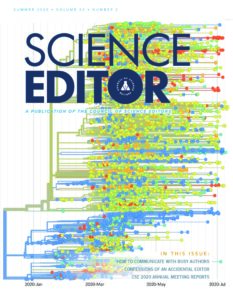For reasons I don’t fully understand, I collect tweets of authors complaining about journal policies and procedures. Here’s one from just this week where an author posted a screenshot of a journal email informing them their manuscript was returned because the font size was wrong. Personally, I lean toward the “format-free” faction for initial submissions, or at least a standardized, simple format as suggested in this plea published in Science Editor in 2018: The Painful Publishing Process: A Request to Simplify Bureaucratic Requirements.
One practical reason for being lax on formatting and other superficial elements at first submission is that it can dilute the importance of the essential elements required later in the process. If you’ve been insisting on serifs, font sizes, and margins from the beginning, necessary requirements such as COI disclosures, data availability statements, and reporting guidelines can seem like another trivial task to complete. A key role for journals is ensuring the quality of the peer review process and scientific record, and we need to save our annoyance capital to spend on items that serve that goal.
To be fair, there likely is (or at least was) a reason for the tweeted requirement, but is it a good reason? In other words, can you explain to authors why you do what you do? Just answering that question can help you understand an author’s perspective. As Carissa Gillman describes in her recent interview, recognizing where authors are coming from and what is important to them can make you a better editor. As Becky Rivard notes in her article on How to Communicate with Busy Authors, the skills you develop to work with authors are typically “good skills to have in any profession and in life.”
Scientific publishing should be a mutually beneficial experience for authors and journals, and I believe that we owe it authors to be able to provide reasons for our journal requirements. A good policy or procedure is one that should be hard for an author to reasonably reject. That’s not to say authors won’t try, or that every reasonable seeming policy succeeds, but crafting policy with that principle in mind can help lead both authors and journals to a better place.
-Jonathan Schultz
Editor-in-Chief, Science Editor
ANNOUNCEMENT : New Issue!
The Summer 2020 issue of Science Editor is now available online and (hopefully) in your mailboxes soon. For more on the articles in this issue, see my Viewpoint, Adaptation: Changing to Meet a Global Challenge.
Reminder: We’re looking for suggestions for our new Science Editor interview series of CSE members and other professionals in science editing and publishing. We’re particularly interested in highlighting editors and professionals from diverse and non-traditional backgrounds, especially if you have an interesting story to share. If you are interested in participating or would like to recommend a colleague, send your info or suggestions to scienceeditor@councilscienceeditors.org
From the Archives
One way to know what authors need is to ask them. And since you’re unlikely to have the time to ring up all your authors, a survey can be the next best thing. To help with that, Jessica Rucker and Jody Plank of the American Chemical Society provide an overview of their process in a 2018 article, Author Surveys: Insights into Iterative Author Survey Campaigns One piece of advice from the article: “Test, test, and retest your surveys before launch.”
Hot Articles from Recent Issues (For CSE Members only)
As a CSE member benefit, once Science Editor articles are moved to an issue, they are available only to CSE Members for one year.
If you’re like me, as noted in the Summer issue Viewpoint, you have a special place in your heart for the last in-person conference you were able to attend. For Barbara Gastel and her team of reporters, that conference was likely 2020 AAAS Annual Meeting held this February in Seattle (remember when conferences had locations?). In their recent article “Envisioning Tomorrow’s Earth (during a Rather Different Yesterday),” they provide useful recaps of the sessions of interest to science editors and communicators, covering topics such as reproducibility, science journalism, and combating mis-information. Of note, at that meeting, CSE Past President Monica Bradford was inducted as an AAAS Fellow (congrats!).
Not a CSE member? Additional membership info along with instructions for becoming a member of the Council of Science Editors can be found here.
Resource of the Month
If you publish research relying on animal models, you are probably (hopefully!) familiar with the ARRIVE guidelines to “improve the reporting of research involving animals.” Last month, ARRIVE 2.0 published in PLOS Biology, and you can read an editor’s take on the update at the BMC Blog. One of the new features I like is they have split the checklist into Essential and Recommend sections, helping guide authors and possibly increase adherence.
Multi-Language Authors
I was not familiar with the term “multi-language author” until reading about it in Becky Rivard’s Annual Meeting Report on the session Working with Multi-Language Authors, but it’s a term I hope becomes commonplace. Outside of the context of a class to teach English, “non-native English speaker” and “English as a second language” can both imply a bit of a pejorative, that the author’s English is inherently weaker as it was not their first language; “multi-language author” is more neutral, and therefore, more positive. The report includes many tips and suggestions from the speakers for working more collaboratively and positively with multi-language authors.
Feedback and suggestions are always welcome at scienceeditor@councilscienceeditors.org.
We are also always looking for new submissions or article suggestions you may have; for more details, see our Information for Authors.
